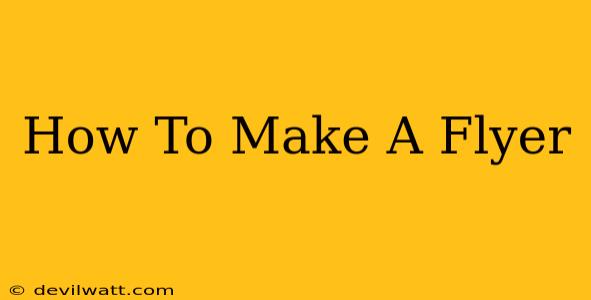Creating a flyer that grabs attention and drives results isn't just about slapping some text and images together. It's about strategic design and understanding your target audience. This guide will walk you through the process of making a flyer that truly works, from initial brainstorming to final distribution.
Understanding Your Purpose: Before You Even Open Design Software
Before you even think about fonts or colors, ask yourself these crucial questions:
- What's the goal of your flyer? Is it to announce an event, promote a sale, or increase brand awareness? A clear objective will guide your design choices.
- Who is your target audience? Understanding their age, interests, and preferences will help you choose the right style, language, and imagery. A flyer for a teen dance party will look drastically different than one for a retirement community event.
- What's your call to action (CTA)? What do you want people to do after seeing your flyer? Visit your website? Call a number? Attend an event? Make your CTA clear and prominent.
Designing Your Flyer: The Visual Appeal
Now for the fun part! But remember, "fun" doesn't mean haphazard. Effective flyer design follows these key principles:
1. Choose the Right Size and Format
Flyer sizes vary, but common choices include:
- Standard (8.5 x 11 inches): Versatile and easy to print.
- Half-page (8.5 x 5.5 inches): Good for smaller events or promotions.
- A5 (5.8 x 8.3 inches): A popular international standard.
Consider where your flyer will be displayed. A larger format might be necessary for high-traffic areas, while smaller sizes are better suited for handouts.
2. Create a Visually Stunning Layout
- Headline: Your headline needs to be eye-catching and instantly communicate your message. Use a large, bold font.
- Subheadings: Break up large chunks of text with subheadings to improve readability.
- Body Text: Keep your text concise and easy to read. Use a clear, legible font. Avoid overly long paragraphs.
- Images/Graphics: High-quality images and graphics can significantly enhance your flyer's appeal. Ensure they're relevant to your message and high-resolution.
- White Space: Don't overcrowd your flyer! White space (empty space) is essential for readability and visual appeal. It allows the eye to rest and focus on important information.
- Color Scheme: Choose colors that are consistent with your brand and appeal to your target audience.
3. Crafting Compelling Copy
Your text needs to be concise, persuasive, and easy to read. Remember the following:
- Strong Verbs: Use action verbs to make your message more dynamic.
- Benefit-Oriented Language: Focus on the benefits your product or service offers to the reader.
- Clear and Concise Language: Avoid jargon and technical terms.
- Proofread Carefully: Errors can damage your credibility.
Choosing Your Design Tools
Many options exist for creating flyers, ranging from free online tools to professional design software:
- Free Online Tools: Canva, Adobe Express, and others offer user-friendly interfaces and templates. These are great for beginners.
- Professional Software: Adobe Photoshop and InDesign offer greater control and flexibility but require more design skills.
Printing and Distribution
- Print Quality: Choose a high-quality printing service to ensure your flyer looks its best.
- Paper Stock: Consider using a thicker paper stock for a more professional look and feel.
- Distribution Strategy: Where will you distribute your flyers? Consider high-traffic areas, strategic locations relevant to your target audience, and even online distribution.
Key Considerations for Success
- Target Audience Focus: Always keep your target audience in mind throughout the design process.
- Strong Call to Action: Make it clear what you want people to do.
- High-Quality Images: Use professional, high-resolution images.
- Consistency: Maintain consistency in your branding and messaging.
- Testing and Refinement: Don't be afraid to test different designs and refine your approach based on results.
By following these steps, you'll be well on your way to creating a flyer that not only looks great but also delivers tangible results. Remember that your flyer is a marketing tool – make it count!

